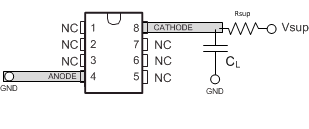SLVSE73 June 2017 LM385-1.2-MIL
PRODUCTION DATA.
10 Layout
10.1 Layout Guidelines
Figure 12 shows an example of a PCB layout of LM385x-1.2-MIL. Some key Vref niose considerations are:
- Connect a low-ESR, 0.1-μF (CL) ceramic bypass capacitor on the cathode pin node.
- Decouple other active devices in the system per the device specifications.
- Using a solid ground plane helps distribute heat and reduces electromagnetic interference (EMI) noise pickup.
- Place the external components as close to the device as possible. This configuration prevents parasitic errors (such as the Seebeck effect) from occurring.
- Do not run sensitive analog traces in parallel with digital traces. Avoid crossing digital and analog traces if possible and only make perpendicular crossings when absolutely necessary.
10.2 Layout Example
 Figure 12. Layout Diagram
Figure 12. Layout Diagram